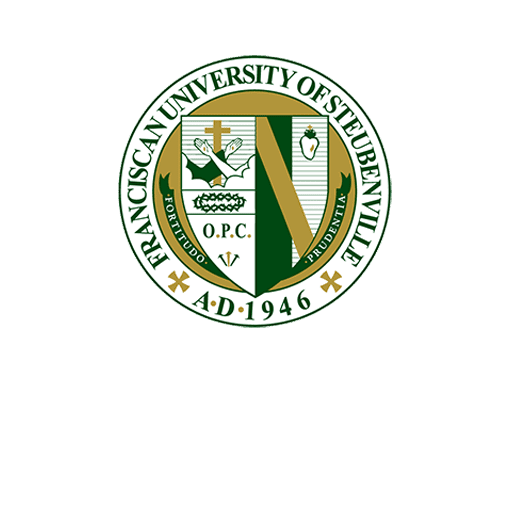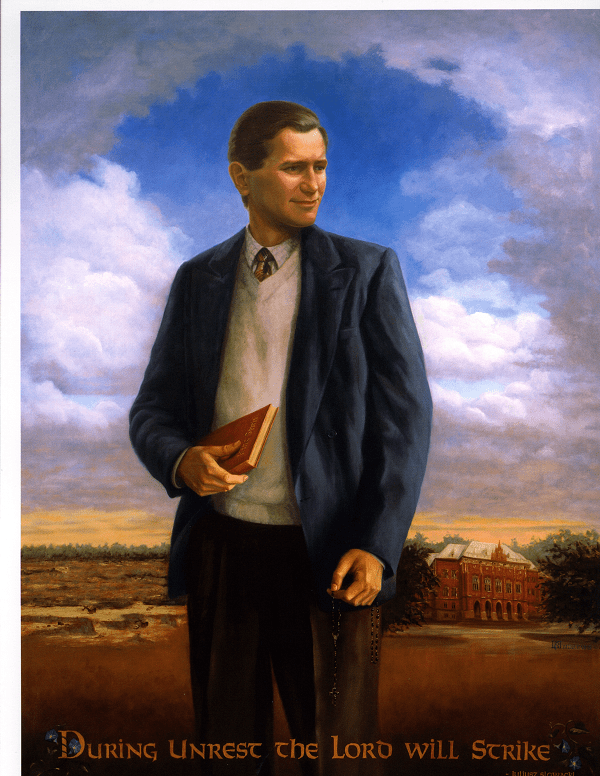The St. John Paul II Library is a member of OPAL (Ohio Private Academic Libraries) and OhioLINK. Through these memberships students, faculty and staff have borrowing privileges at libraries in Ohio including public and private universities/colleges and the State Library of Ohio as well as some public libraries. The St. John Paul II Library offers quiet study areas, a computer lab and group study rooms throughout the two floors of the library. The library collection consists of countless resources including a substantial print and e-book collection, online databases and resources, media, the Franciscan University of Steubenville archive and special collections (e.g., St. John Paul II, Franciscan, Phenomenology, and Juvenile), and more! Student support and assistance is available through one-on-one and classroom instruction, email, chat, and phone.
About Us
Franciscan University of Steubenville
By providing information resources and services to enhance teaching, learning and research, the St. John Paul II Library supports Franciscan University’s mission of being academically excellent and passionately Catholic.
Students, faculty and staff are welcome to suggest books, journals, videos and other items to be included in the library’s collection. You can give your recommendation to any member of the St. John Paul II Library staff.
These factors are considered when evaluating a book or video for purchase:
- Academic in nature, although exceptions will be made for items of interest to a broader Catholic audience
- Availability of existing copies in the OPAL and OhioLINK systems
- Cost
- Language
- Reputation of the author
- Reputation of the publisher
- Relevance to the curriculum
- Textbooks will be purchased if they are placed on reserve at the library
- Whether the resource is highly specialized and will serve a few users or is of interest to a broader audience
Because of the expense and ongoing commitment of a journal subscription, these additional factors are considered when evaluating a new title:
- Online and print availability, with full-text online the preferred format
- Price of each option
- Courses or programs supported
- Availability of backfiles
- Limited overlap with other electronic resources
- Unlimited simultaneous users
- Use statistics are provided
Info coming soon
Withdrawl of library materials (weeding) is necessary to maintain an effective, academically useful collection that reflects the changing needs of the library patrons and current developments in every subject area. The library’s withdrawl policy recognizes that our holdings have moved from the “just in case” depository approach to the “just in time” system that is supported by our consortial memberships. Our goal is to meet patron needs and not to store or warehouse books.
The collection is analyzed on an ongoing basis to identify items that are not circulating; items that have superseded, dated or obsolete information; and materials in poor condition.
General guidelines used to evaluate items for withdrawl:
- Use patterns. The ACRL recommends that items that have not been used in 10 years should be removed from the collection. Exceptions to this rule include items considered classic works in their field, books authored by faculty and items of local interest.
- New editions that superseded older editions. Items with erroneous or outdated information, especially works in the sciences or technical areas that are over five years old.
- Items that support academic programs or courses that have been discontinued.
- Multiple copies of items, except for titles with heavy use or those requested by faculty for reserve.
- Age. With the exception of humanities, anything over 10 years old should be considered for deselection.
- Condition. Items that are damaged beyond repair.
The professional staff of the library retains the right to make the final decision on withdrawing items.
Items will be retained if:
- It has been checked out at least once in the past ten years
- It is the current edition
- It is a primary source
- It supports the curriculum
- It is considered a classic in its field
- It is the last copy in OPAL
- It is in good condition – no marks in the text, tight binding, etc.
Damaged items will be replaced if:
- It is the current edition
- It has been checked out at least two times
- It is considered a classic in its field
- It supports the curriculum
- If the damaged item is older than ten years, a more recent publication on the same topic will be considered
The cost to the patron to replace a damaged item will be determined by the acquisitions librarian.
Comments from the artist, Lisa Steinbrenner Andrews, made at the presentation of the portrait on April 8, 2005:
I would like to thank Father Terence Henry, Father Mike Scanlan, Frank Glazer, and the Board of Trustees of Franciscan University for having the courage and the confidence in me to undertake this project. I would also like to thank Susan Hunt for being such a help in coordinating all the details to make this happen, to Charles White and his Physical Plant staff for such a great job in hanging and lighting the painting, Bill Jakub and the Library Staff, and all those whose prayers supported me throughout this process.
I would especially like to thank the student body of Franciscan University for providing me with the inspiration for the subject of this painting.
I had no idea when I began this project what a profound impact it would already have on so many people, and it is only being shown publicly for the first time today.
The story of how it came to be is a testament in itself to the way God uses small things to make a difference. As I contemplated an image which would be suitable for this vast wall space, I played with the idea that the John Paul II Library should have an image incorporating the Pope himself. The idea of showing him at the same stage of life as the students of the University seemed both original and appropriate. Before developing the concept further, I wanted to get a “reality check”, so I called my son who is a student here. If he thought it was an idea worth pursuing, I would do it. His immediate reaction was, “Awesome!” That momentary reaction made the difference, another response might have resulted in a different story today. But this is the painting that was meant to hang here.
And today is such a meaningful time for so many to see it for the first time. History does not ask us what we want. But it demands that we participate. I am not a historian or a theologian. But I believe there will be a pre-John Paul II era and a post-John Paul II era in the study of Church history. The full impact of his influence on world history may not be understood for many years. Although we are not the generation to write that chapter, we are the generation to have touched it personally. I think what we are experiencing in the events of the past week must be similar to what Francis of Assisi’s followers experienced at his passing.
This portrait could not hang in any other place and have the same significance, the same impact. It was painted for this precise place, and for you at this precise stage of your lives. In it, I attempted to personalize for you a critical moment in world and Church history when God called, and someone answered.
Karol Wojtyla was once a young adult like you, with the same struggle to find his place in the world. When he heard the roar of bombs on that fateful day while praying at Mass, he knew what direction he would take. In some ways, his decision was easier because it was stark: he could see and touch death at his doorstep. But he chose the way of life and never looked back, giving us all an embodiment of Christ’s love for our own age.
I think a good portrait not only has to look like the person, but it should convey something about his life story through symbols. The Pope was an athletic man, with a casual grace and relaxed demeanor. I placed him off center on the canvas, with his head turned towards the opposite edge, as though he was initially going in one direction in his life, but something caused him to turn towards a different path with confidence and faith. He actually intended to work in the theater when he entered the University, but the world became his stage, instead. The storm clouds are an obvious metaphor, but they are placed both behind him and ahead of him to signify past and future challenges. He, however, is caught in the clear sky with the light of truth illuminating his face.
The quote at the bottom of the canvas, “During Unrest the Lord Will Strike,” is the title and first line of a nineteenth-century mystical poem written by one of the Pope’s favorite Polish authors, Juliusz Slowacki. In it, the poet predicts the election of a Slavic Pope who would one day be a “brother” to humanity. That prediction would come true over a hundred years later with the election of Pope John Paul II.
The letters are bordered by Morning Glory vines, which were traditionally known as “Mary’s Mantle” and used as a symbol of the protective nature of the Blessed Virgin. Karol Wojtyla was saved from death several times in his youth, even before the assassination attempt which prompted him to credit Our Lady with saving his life.
The rosary he holds is another reference to his devotion to Our Blessed Mother. It is actually painted from a 70-year-old family rosary that came from Rome, and which bears a medal with the Papal seal.
The book he holds is inscribed with the words “King Spirit” which was the title of another poem by Slowacki and also the title of the first dramatic production of the theater company the Pope helped found while a student in Krakow during the War.
The landscape on the right shows the façade of Jagellonian University in Krakow where he studied during his freshman year. The landscape on the left side is of the stone quarry where he was forced to work by day after the Nazi invasion of Poland in September of 1939. At night, he and other students met in safe houses to take classes from faculty of the University who survived the Nazi purge.
I hope as you look at this portrait, you see some of the strength and compassion that marked the very essence of this man. His greatness lay most clearly in his deep love of humanity and in his ability to elevate even the simplest person to see the love of God. I hope it inspires you to look deeper into the life and teachings of this great gift we were privileged to share during our lifetime.
And I ask you to ponder one last thing: If this were a portrait of you, would your head be in the clouds, or in the clarity of truth? Would you be looking towards the future with hope, or casting your eyes in another direction? Would you have the strength of reason in your hand, and faith in prayer at your fingertips, or would you be grasping at your future with empty hands? What would your portrait look like?



